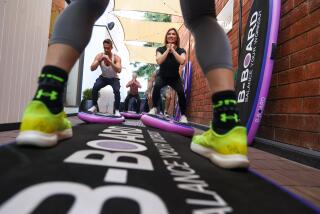Here’s the Long and the Short of Choosing Your First Board
- Share via
It’s time to talk turkey. No, not the Thanksgiving kind. Fig and I were talking, ‘cause you know, we do that a lot, and the subject of picking out a starter surfboard came up.
It is the one piece of surfing equipment that can put the biggest dent in a parent’s bank account (See, we know who writes the check).
Fig and I believe that too many grommets--kidlets who eat, talk, and dream surf--see a neat picture of a pro surfer in one of the surf mags, and Boom! It’s I-Want-That-Kinda-Board time.
“But honey, you need sweaters this year.”
Sorry, Mom. What I need is a surfboard like Christian Fletcher’s, with neat-looking daggers, dripping blood and skulls.
I asked Fig about his first surfboard.
I remember it pretty well. It was a 10-foot Wardy. We were living at the beach, and my parents had a rental at Sunset Beach. The tenant skipped out without paying the rent, and he left this big 10-foot log behind. I could only grab the nose and drag it across the sand to the shore.
Fig hated high tide. See, his idea of a good day was to have mellow surf and low tide. Fig’s different now. But then, his big concern was that if he fell off the big beast, it would be in shallow water where he could at least see the bottom.
Even with experience, you never say you’re gonna conquer the ocean, ‘cause if you do, you’ll always lose.
Take Fig’s son, Rick Jr., age 6. Fig Dad waited until his son learned to swim in a swimming pool. Then he introduced him to the blue Pacific for that all-important Dad Takes Junior on His First Outing.
Only Junior wasn’t ready.
When he was 5, we started taking him to the beach. But he was always afraid out there, not being able to see the bottom, and so many waves and all that water action.
I tried to take him out on a surfboard, a short one about six feet long. I felt that was almost a little too much for him. If it was to hit him and stuff, it would rack him up. So we switched to a boogie board.
Boogie boards are like pillows. They’re nice and soft.
Ricky Jr. has overcome his fear and says, “Now, I like going way far, far out.” Well, not that far out.
Soft surfboards are the ticket too, Fig said. Essentially, they’re Nerf boards that are shaped like a surfboard, have a single fin but instead of fiberglass, they’re foam. If you get bonked on the head, you can still drive home.
Fig said Peter Townend, a former world titleholder from Australia who now lives in Fountain Valley, has a couple of kids he trained on soft boards. They’re now regulars at surfing contests.
Hey, Fig, how about fins? Tell ‘em about thrusters.
Simon Anderson is credited for the tri-fin design. They’re called a thruster and are propelled by having two front fins, sucking water through, because they’re toed in and angled out and cause a venturi effect (Whoa, you get that?). And then the third fin in the back is a stabilizer fin to hold you in and actually give you a little propulsion too.
You gotta love the guy.
Many people argue that the single fin is obsolete. Fig disagrees and says he knows a lot of people who still ride them.
They’re good as long as the wave has speed. The single was OK, but over the flat spots it just couldn’t keep the momentum going, because it didn’t have that venturi effect.
And the twin fin popularized by former world pro titleholder Mark Richards?
On twin fins you tend to pop a fin out of the water during radical turns and you end up sliding a little bit. But with a thruster you have two fins in the water, eliminating that tail drift. You can get more radical in a steeper section of the wave face and can go CRACK off the lip!
Sooo, Fig and I agree that your first board should be a little bit longer and wider than what you originally wanted.
Here’s the thing: To a grommet, a surf shop means only one thing: Candyland. It would be nice to tell these kids to start on a mini-nose rider, a real fun board, but you probably won’t find one willing to do that.... They gotta realize they need more thickness and width, something that they can use as a beginner and take into the intermediate stage too.
You paying attention? Consider the cost. Long boards can run $450 or more. But short board prices have gone sky-high. Today’s state-of-the-art board can start at $400. Throw in some color, a coupla skulls and a Godzilla mood ring, and you’re looking at $450 easy (we’re leaving out long boards shaped by say, Greg Noll, which can command $2,500 apiece).
Be patient. You can always trade up to that high-performance board with a four-ounce glass job, carbon-fiber strips for strength, and ultralight foam.
Their column appears in O.C. Live! the first three Thursdays of every month.


